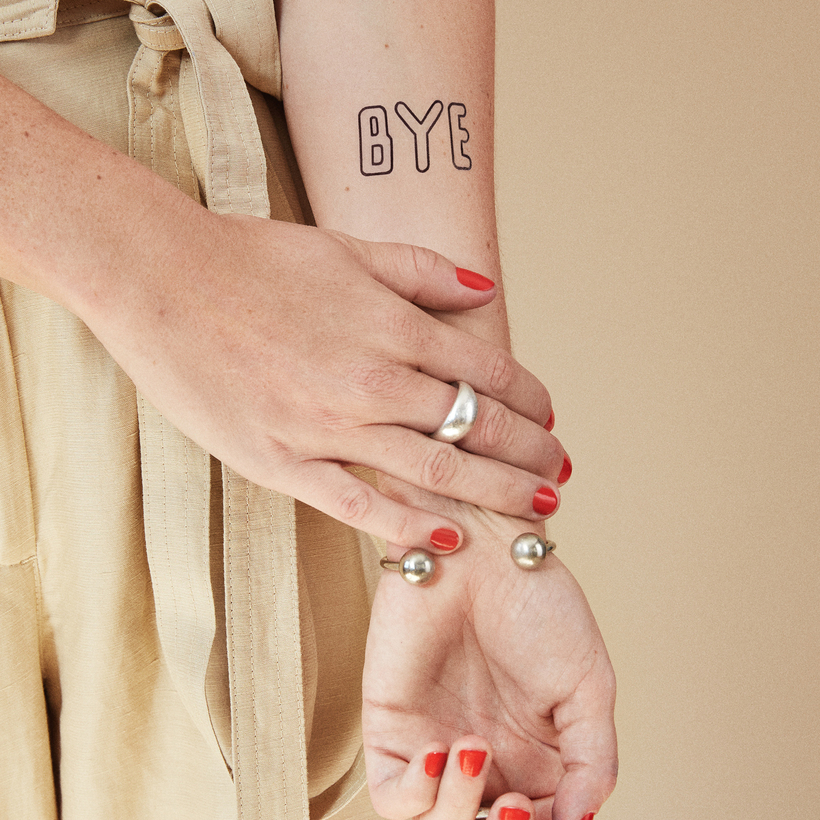A couple of years ago, my friend’s husband came home from his first tour in Iraq. He’d been telling her, over the phone, that he had something special to show her when he got home, a surprise. They’d been married for a little more than a year—the ceremony, held shortly after high-school graduation, was followed by a dinner at McDonald’s—and he’d been gone for most of it.
Now returned, he showed her a tattoo he’d gotten just above his heart. It was of a nun, who was holding up the skirt of her habit to reveal a large, purple, strap-on dildo.
I thought of this story on a recent Friday afternoon when I went to Ephemeral, the world’s first “made-to-fade tattoo” shop, which has just opened in Williamsburg, Brooklyn. The writing out front reads, “Regret nothing.” According to Joshua Sakhai, the 24-year-old co-founder of Ephemeral, these words are more than a slogan—they are a “place to stand in life,” a philosophy about “honoring who I am in this moment, knowing I am going to change.”

Sakhai, who grew up on Long Island in a Jewish-Persian family that forbade tattoos, came up with the idea for Ephemeral during his freshman year at New York University. A friend had been complaining about the cost and pain of having had his permanent tattoo lasered away.
“We started thinking, Everyone is focused on removal, but why don’t we start with the ink?,” Sakhai says. Sakhai decided to drop out of N.Y.U.
Six years and more than 50 formulations of now patented Ephemeral ink later, his dream is realized in Brooklyn.
Testing the Waters
Ephemerals, which fade in 9 to 15 months, are a good solution for commitment-phobes, the devoutly religious (or those with religious parents), and test-drivers. They cost roughly the same amount as a regular tattoo (around $250 to $450, depending on size and placement), and hurt roughly as much. At their peak, Ephemerals are indecipherable from the real thing, and require no further fees or pain to get rid of—they just disappear without a trace, thanks to the biodegradable ink Sakhai and C.E.O. Jeffrey Liu developed with a team of chemical engineers.
The market for Ephemeral is vast, but Sakhai prefers to speak in less mercenary terms. “There are millions of people out there who want to express themselves, who want to take ownership of their stories and their bodies through this art form,” he told me, “but they’re stopped in their tracks.” Ephemeral jump-starts them, he said. “And not only with the technology but also with our studio.”
Past the slogan and inside, signs of a well-studied millennial-Instagram haven are everywhere, from the (unlit) scented candle on the matte minimalist check-in table to the adjacent waiting area decked out in muted pastels, rose gold, bamboo, a shag carpet with a geometric design, and enough succulents to fill a human-size terrarium.

Chelsea, an artist who works at the shop but comes from a traditional-tattoo background, has an Ephemeral on her leg, plus countless permanent tattoos on her knuckles, ears, and so on and so forth. The Ephemeral process, from the design techniques to the tattoo guns to the professional body artists, is very similar to that of regular tattoos. But Chelsea still understands why the other tattoo shops in the area—there is one on the same block—don’t like Ephemeral.
She laughed when I told her about the nun tattoo, and said she wouldn’t object to such a request, that she’d be into it. But she says it’s probably not the type of thing she’d do at Ephemeral. So far Chelsea has worked mostly on social-media influencers, girls who tend to ask for “random stuff, little things”—designs like lotus flowers and half-moons. According to Chelsea, no one has taken advantage of the disappearing ink to get something that carries a high risk of regret.
When my friend saw the nun tattoo, she was horrified, which perplexed her husband. He told her, hand over nun—over heart—that he absolutely loved this tattoo. They got divorced.
Clementine Ford is an Associate Editor for Air Mail


